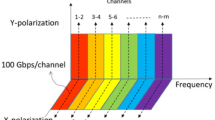Abstract
We propose analytical modelling of component crosstalk on the performance of wavelength division multiplexed (WDM) receiver with generalized quadrature phase shift keying (QPSK) signal and coherent detection. A comprehensive study on the signal-to-noise ratio (SNR) penalty is conducted, which can be used to balance SNR values and the system's power budget in the presence of finite crosstalk sources. Results express that, in the presence of five crosstalk interferers, the crosstalk level leading to 1-dB of SNR penalty must be less than -23.8 to -26.5 dB for bit error rate (BER) from 10–7 to 10–13. For the BER of 10–9, the QPSK signal has a component crosstalk tolerance of -21.7 dB for a 1 dB SNR penalty with a single interferer. Furthermore, the study of spectral efficiency reveals that crosstalk level, SNR, and the number of active interferers perform a vital role in determining the bandwidth efficiency of the system. The analysis exploits the characteristic function method and Maclaurin series expansion to compute a closed form expression of BER over additive white Gaussian noise (AWGN) channel. Following the analysis, the SNR and bandwidth expenses of the system are examined numerically through the estimated BER and binary entropy function. The estimated values of the BER using the proposed model are in close agreement with a similar theoretical investigation for a single interferer.









Similar content being viewed by others
References
Zhang Q et al (2020) Accurate BER estimation scheme based on K-means clustering assisted gaussian approach for arbitrary modulation format. J Lightwave Technol 38(8):2152–2157. https://doi.org/10.1109/JLT.2019.2956804
Fernando XN (2014) Power link budget and cumulating SNR. In Radio over Fiber for Wireless Communications: From Fundamentals to Advanced Topics. IEEE, pp.47–60. https://doi.org/10.1002/9781118797051.ch3
Krongold B, Pfau T, Kaneda N, Lee SCJ (2012) Comparison between PS-QPSK and PDM-QPSK with equal rate and bandwidth. IEEE Photonics Technol Lett 24(3):203–205. https://doi.org/10.1109/LPT.2011.2174978
Cheng J, Beaulieu NC, Zhang X (2005) Precise BER analysis of dual-channel reception of QPSK in Nakagami fading and cochannel interference. IEEE Commun Lett 9(4):316–318. https://doi.org/10.1109/LCOMM.2005.1413619
Sarkar S, Das NR (2009) Study of component crosstalk and obtaining optimum detection threshold for minimum bit error rate in a WDM receiver. J Lightwave Tech 27:4366–4373
Ho K-P (2005) Phase-Modulated Optical Communication Systems. Springer-Verlag, New York
Goldstein EL, Eskildsen L, Elrefaie AF (1994) Performance implications of component crosstalk in transparent lightwave networks. IEEE Photonics Technol Lett 6(5):657–660. https://doi.org/10.1109/68.285571
Ho KP (1999) Analysis of homodyne crosstalk in optical networks using Gram-Charlier Series. J Lightwave Technol 17(2):149–154
Kamalakis T, Sphicopoulos T (2003) Asymptotic behavior of in-band crosstalk noise in WDM networks. IEEE Photon Technol Lett 15(3):476–478
Mukherjee P, Sarkar S, Das NR (2021) Spectral efficiency and quantum limit of BPSK transmission in a WDM system in presence of multiple interferers. Photon Netw Commun 42:134–141. https://doi.org/10.1007/s11107-021-00945-9
Dalakas V, Kamalakis (2016) Comparative study of modulation and coding schemes for coherent indoor optical wireless systems. Opt Quant Electron 48:374
Mukherjee P, Sarkar S, Das NR (2017) An approach for realistic estimation of BER due to signal-component crosstalk in a WDM receiver. Optik 146:1–7
Winzer PJ (2012) High-spectral-efficiency optical modulation formats. J Lightwave Technol 30(24):3824–3835
Zhang F et al (2011) Experimental comparison of different BER estimation methods for coherent optical QPSK transmission systems. IEEE Photonics Technol Lett 23(18):1343–1345. https://doi.org/10.1109/LPT.2011.2160718
Giorgetti A, Chiani M (2005) Influence of fading on the Gaussian approximation for BPSK and QPSK with asynchronous cochannel interference. IEEE Trans Wireless Commun 4(2):384–389. https://doi.org/10.1109/TWC.2004.843036
Chiani M, Giorgetti A (2002) Statistical analysis of asynchronous QPSK cochannel interference. Global Telecommunications Conference, 2002. GLOBECOM '02. IEEE, vol. 2, pp. 1855–1859. https://doi.org/10.1109/GLOCOM.2002.1188520
Hamdi KA, Pap L (2007) Exact BER analysis of binary and quaternary PSK with generalized selection diversity in cochannel interference. IEEE Trans Veh Technol 56(4):1849–1856. https://doi.org/10.1109/TVT.2007.897238
Beaulieu NC (1991) The evaluation of error probabilities for intersymbol and cochannel interference. IEEE Trans Commun 39(12):1740–1749. https://doi.org/10.1109/26.120161
Beaulieu NC, Abu-Daiya AA (1995) Bandwidth efficient QPSK in cochannel interference and fading. IEEE Trans Commun 43(9):2464–2474. https://doi.org/10.1109/26.412721
Ho KP (2011) Effects of homodyne crosstalk on dual-polarization QPSK signals. J Lightwave Technol 29(1):124–131. https://doi.org/10.1109/JLT.2010.2095830
Taher KA, Majumder SP (2017) Analytical evaluation of the effect of cross-polarization-induced crosstalk on the BER performance of a PDM-QPSK coherent homodyne optical transmission system. J Opt Commun 38(2):213–222. https://doi.org/10.1515/joc-2016-0072
Kramer G, Ashikhmin A, van Wijngaarden AJ, Wei X (2003) Spectral efficiency of coded phase-shift keying for fiber-optic communication. J Lightwave Technol 21(10):2438–2445. https://doi.org/10.1109/JLT.2003.817704
Verdu S (2002) Spectral efficiency in the wideband regime. IEEE Trans Inf Theory 48(6):1319–1343. https://doi.org/10.1109/TIT.2002.1003824
Baricz A (2010) Powers of modified Bessel functions of the first kind. Appl Math Lett 23(6):722–724
Papoulis A (1984) Probability, Random Variable, and Stochastic Processes. McGraw-Hill, New York
Abramowitz A, Stegun I (1972) Handbook of Mathematical Functions, 9th edn. Dover, New York
Proakis JG (2000) Digital Communications. McGraw-Hill, New York
Author information
Authors and Affiliations
Corresponding author
Ethics declarations
Conflicts of interest
Not applicable
Additional information
Publisher's note
Springer Nature remains neutral with regard to jurisdictional claims in published maps and institutional affiliations.
Rights and permissions
Springer Nature or its licensor (e.g. a society or other partner) holds exclusive rights to this article under a publishing agreement with the author(s) or other rightsholder(s); author self-archiving of the accepted manuscript version of this article is solely governed by the terms of such publishing agreement and applicable law.
About this article
Cite this article
Mukherjee, P., Sarkar, S. & Das, N.R. Analysis of SNR penalty in coherent WDM receiver system for detection of QPSK signal with component crosstalk. Ann. Telecommun. 78, 577–584 (2023). https://doi.org/10.1007/s12243-023-00958-7
Received:
Accepted:
Published:
Issue Date:
DOI: https://doi.org/10.1007/s12243-023-00958-7




